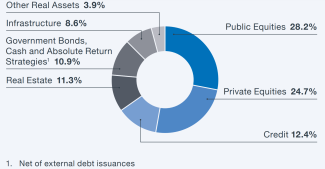
The Growing Need for Alternative Investments
Last month I touched on the benefits of portfolio diversification, namely through the use of stocks and bonds. Today, I want to discuss why low interest rates and positive correlations between traditional asset classes may be the end of the traditional 60/40 portfolio, and why adding alternative investments into your portfolio might be a prudent move.
The 60/40 portfolio is based on a 60% allocation to stocks and a 40% allocation to bonds with the intent of the two assets classes being negatively correlated with one another, and the goal of smoothing out the returns in your investment portfolio. This helps us stay invested and sleep better at night! Historically, this has worked well as stocks and bonds have been negatively correlated with one another. (Ie. In any one year stocks could be down and your bond allocation is positive, and vice versa.) However, over the last couple of decades this trend has reversed. (See chart below)

Starting around 1990 the correlations between stocks and bonds have been increasing, to the point where they have now been positively correlated for almost 20 years. With stocks and bonds being positively correlated the volatility of your investment portfolio returns would have increased. This is one of the main reasons why adding alternative investments to your portfolio may be a benefit. Alternative investments have shown to have reduced correlation to traditional asset classes. (Source: Baird) Another reason why the 60/40 portfolio may be challenged in years to come is because of the current level of interest rates.
Interest rates have been steadily decreasing over the last 30 (see chart below), and this has been incredibly positive for the bond market performance. When interest rates rise, bond prices will fall, and when interest rates fall, bond prices rise. This trend of lower and lower interest rates would have been excellent for the performance of your portfolio bond allocation. However, since we are now sitting at the lowest Bank of Canada benchmark interest rate in history (0.25%), any future trend of rising interest rates will not be good for a typical bond allocation.

This phenomena of lower interest rates and positive correlation to stocks has created the requirement for large institutional managers and retail investors to further diversify among other asset classes which will reduce correlations inside their portfolio and enhance returns. This has pushed them into allocating more and more into the alternative investment space.
So what are alternative investments and how can they help?
Investment alternatives could be defined to include both alternative assets and also alternative strategies. Alternative assets could include commodities, infrastructure, real estate, and currencies, while alternative strategies could include long/short, event driven, or global macro. Some of these strategies can incorporate an absolute return objective (maintaining a positive year over year return).
One potential benefit of adding alternatives into your portfolio would be to reduce positive correlation inside the portfolio, and have opportunities to generate returns independent of what the market is doing.
It's not just us increasing our allocation to this space... some of the biggest pension managers around the world also incorporate these assets.
For example, let's take a look at how the Canadian Pension Plan (CPP) has increased their allocation to the alternative space over the last two decades.

Source: CPP Annual Investment Report 2020
What started out as a portfolio allocated 100% to Canadian government bonds has changed its tune over the last 20 years to reduce its allocation to fixed income, and increase its allocation to the real asset space. Inside their "real asset" sleeve, they include absolute return strategies, and allocations to infrastructure, real estate, and resources.
Oh, and let's not forget that they've decided to run with active management for their equity portfolio! This is something we've always focused on and have shifted towards even higher active management in the last number of years. For a refresher on the difference between active and passive management please click here.
Jon

Jonathan Adomait
Financial Advisor, BASc
P.S - Have questions or want us to discuss a particular topic? Let us know by sharing your feedback!

